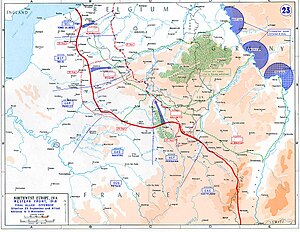| Hundred Days Offensive | |||||||
|---|---|---|---|---|---|---|---|
| Part of the Western Front of World War I | |||||||
 Allied gains in late 1918 | |||||||
| |||||||
| Belligerents | |||||||
|
|
| ||||||
| Commanders and leaders | |||||||
|
|
| ||||||
| Strength | |||||||
|
Strength on 11 November 1918:[3] |
Strength on 11 November 1918:[3] | ||||||
| Casualties and losses | |||||||
|
18 July – 11 November: 1,070,000[4] |
18 July – 11 November: 100,000+ killed 685,733 wounded 386,342 captured 6,700 artillery pieces Breakdown 2,500 killed 5,000 captured 10,000 wounded | ||||||
The Hundred Days Offensive (8 August to 11 November 1918) was a series of massive Allied offensives that ended the First World War. Beginning with the Battle of Amiens (8–12 August) on the Western Front, the Allies pushed the Imperial German Army back, undoing its gains from the German spring offensive (21 March – 18 July).
The Germans retreated to the Hindenburg Line, but the Allies broke through the line with a series of victories, starting with the Battle of St Quentin Canal on 29 September. The offensive led directly to the Armistice of 11 November 1918 which ended the war with an Allied victory. The term "Hundred Days Offensive" does not refer to a battle or strategy, but rather the rapid series of Allied victories.
- ^ Caracciolo, M. Le truppe italiane in Francia. Mondadori. Milan 1929
- ^ Julien Sapori, Les troupes italiennes en France pendant la première guerre mondiale, éditions Anovi, 2008
- ^ a b Neiberg p. 95
- ^ a b Tucker 2014, p. 634.
- ^ Bond 1990, p. 20.
- ^ a b c Reid 2006, p. 448.
- ^ Statistics of the Military Effort of the British Empire During the Great War 1914–1920, The War Office, pp. 356–357.
Cite error: There are <ref group=lower-alpha> tags or {{efn}} templates on this page, but the references will not show without a {{reflist|group=lower-alpha}} template or {{notelist}} template (see the help page).